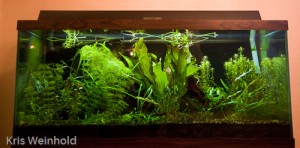January 2009 Meeting
To kick off the new year GWAPA had its first meeting of 2009 at Viktor’s home in Gaithersburg, MD. Along with several breathtaking tanks to view, those in attendance were privy to a talk on a great DIY topic: collecting driftwood. With over 35 folks in attendance, it was a great turnout of both new and seasoned members.

Viktor's 125G
Administratively a few announcements were made first in review of the annual Board of Directors meeting, including the notice of a field trip opportunity with one of our sister clubs NASH (based in Houston, TX and run by our speaker from last July’s meeting Luis Navarro), a possible road trip of our own to Florida, the results of our annual member survey, and thoughts about some changes in format to our nano competition. We also reviewed the new rules for the auction–while staring at the table overflowing with over 100 items to be auctioned off.

Viktor's 30G
Viktor began his talk with a simple statement: he has never paid for driftwood. Growing up in Hungary it simply wasn’t available, which began the learning process. He cautioned against using pine or red cedar because they will release toxins into the water, and to always choose dead wood. If possible, collect pieces from a fast-flowing stream, or soak what you’ve collected in an outdoor pond for several months to allow the tannins to be released and the wood to be waterlogged enough to sink. Also, collect hard wood-nothing that you can dent with your fingernail. Pieces from the root structure of a fallen tree will have good mass and are generally more interesting pieces to use in an aquascape. It is also ok to use saltwater driftwood, just make sure to clean it well. He outlined the cleaning process in detail:
- Clean the pieces by first scraping off any bark or loose pieces with a knife. These bits will rot when kept waterlogged.
- Scrub the wood thoroughly while rinsing with water. Make sure to remove any small, soft or loose pieces.
- To disinfect and sterilize the wood you can wash it in your dishwasher (without detergent, and make sure your washer doesn’t have liquid drying solution like “Jet Dry”), you can soak it in a bleach solution for a few days (following with a soak in clean water for several days until the wood no longer smells of chlorine), you can bake the wood in your oven (if you’re around to monitor it closely!), or the most popular method is to boil the pieces in a large pot (if the pieces are larger than the pot go by sections and rotate the piece to get everything boiled).
- Once in your tank the wood will most likely still release tannins, to get rid of them you can use activated carbon in your filter or Seachem’s Purigen.
- Driftwood fungus is common. Generally it presents as a white, spongy film or fuzz on the wood. It is harmless, and fauna such as Ottos and some Plecos will eat it. The fungus will generally run its course and disappear within a month or so.

Viktor's 75G
Some suggestions from the members for collecting sites were any wooded areas in the area with dense tree populations and Roosevelt Park along the Potomac River. Viktor also agreed to lead a collecting party sometime in the Spring when the weather clears and is a bit more tolerable. We’ll be sure to keep that in mind!

Tags: Add new tag